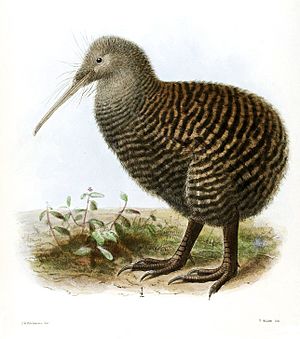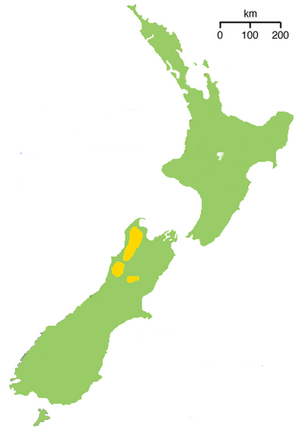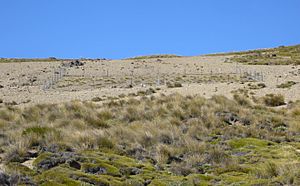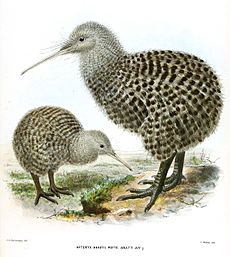Great spotted kiwi facts for kids
Quick facts for kids Great spotted kiwi |
|
|---|---|
 |
|
| Illustration of a female | |
| Conservation status | |
| Scientific classification | |
| Genus: |
Apteryx
|
| Species: |
haastii
|
 |
|
| Range of the great spotted kiwi | |
| Synonyms | |
|
|
The great spotted kiwi (also called the great grey kiwi or roroa) is a special bird from the South Island of New Zealand. It's the biggest type of kiwi and cannot fly. These kiwis live in high, tough mountains. This helps keep them safe from animals brought to New Zealand, like dogs, ferrets, cats, and stoats. Sadly, their numbers have dropped by 43% in the last 45 years. This is mainly because of predators and losing their homes. Because of this, they are now seen as a vulnerable species.
Great spotted kiwis are known for being quite protective. They will defend their home areas from other kiwis. They are nocturnal, meaning they are active at night. During the day, they sleep safely in their burrows. At night, they search for food, which includes small creatures without backbones (like worms) and plants. Their breeding time is from June to March. They lay one of the biggest eggs compared to their body size of any bird. The egg takes about 75 to 85 days to hatch. After the chicks hatch, their parents leave them to learn on their own.
Contents
About the Great Spotted Kiwi
The great spotted kiwi is one of five types of kiwis that live in New Zealand. The other four are the tokoeka (Apteryx australis), Okarito brown kiwi (Apteryx rowi), little spotted kiwi (Apteryx owenii), and North Island brown kiwi (Apteryx mantelli). The great spotted kiwi is most closely related to the little spotted kiwi.
All kiwis belong to a group of birds called ratites. This group also includes the emu, ostrich, rhea, and cassowary. Sadly, it also includes the extinct moa from New Zealand and elephant birds from Madagascar. All ratites are birds that cannot fly. Scientists used to think kiwis were closely related to moa. But new DNA research shows that elephant birds are actually the kiwi's closest relatives.
Stories about a large kiwi called the Maori roaroa were told even before scientists knew about the great spotted kiwi. In 1871, two kiwi specimens were brought to the Canterbury Museum. There, they were identified as a new species. They were named after the museum's curator, Dr. Haast.
The great spotted kiwi was first described by Thomas Potts in 1872. The name Apteryx comes from ancient Greek words meaning "without wing." The name haastii is the Latin form of Sir Julius von Haast's last name.
What Great Spotted Kiwis Look Like
Great spotted kiwis are the largest of all kiwis. Males are about 45 cm (18 in) tall, and females are about 50 cm (20 in) tall. Their bill (beak) is long and thin, measuring 9 to 12 cm (3.5 to 4.7 in). Males weigh between 1.2 and 2.6 kg (2.6 and 5.7 lb). Females are heavier, weighing 1.5 to 3.3 kg (3.3 to 7.3 lb).
Their body is shaped like a pear, and they have a small head and neck. Their eyes are small and they don't see very well. Instead, they mostly use their excellent sense of smell. They have short legs with three toes on each foot. Their feathers are soft and look like hair. These feathers can be dark grey to light brown. They have long, stiff hairs (called vibrissae) around their mouth. They do not have a tail.
Kiwis use their strong legs and claws to defend themselves from predators like stoats or ferrets. Since kiwis cannot fly, they do not have hollow bones like flying birds. They also have tiny wings. Great spotted kiwis have a lower body temperature than most other birds. They usually live for 30 to 40 years.
Where Great Spotted Kiwis Live

Great spotted kiwis used to live in many parts of the South Island of New Zealand. But because of predators, their population is now found in only three main areas. These birds mostly live in higher mountain regions. You can find them from northwestern Nelson to the Buller River, along the northwest coast (from the Hurunui River to Arthur's Pass), and in the Paparoa Range. The group living in the Southern Alps is quite separate from the others.
Great spotted kiwis dig many complex, maze-like burrows. One kiwi might have up to fifty burrows in its territory. They often move between these burrows, changing where they sleep each day. Their habitat can be from sea level up to 1,500 meters (4,900 ft) high. However, most are found between 700 and 1,100 meters (2,300 and 3,600 ft) in the subalpine zone. These kiwis live in different places, including tussock grasslands, scrublands, pastures, and forests.
Kiwi Behavior
The great spotted kiwi is a nocturnal bird. This means it is active at night. If kiwis live in an area with no predators, they might come out during the day. But usually, they come out to feed after dark. Like other kiwi species, they have a very good sense of smell, which is unusual for birds.
Male kiwis are very protective of their territory. Only about four to five kiwis live in one square kilometer (0.4 square miles). One pair's territory can be as large as 25 hectares (62 acres). It is not known exactly how they defend such a large area for their size. They will call, chase, or fight other kiwis that enter their space. Great spotted kiwis make sounds like growls, hisses, and bill snapping. Male great spotted kiwis make a warbling whistle sound. Female kiwis make a harsh, raspy, warbling sound.
Reproduction and Life Cycle
| Location | Population | Date | Trend |
|---|---|---|---|
| Buller River to Nelson | Unknown | Declining | |
| Paparoa Range | Unknown | Declining | |
| Arthur's Pass National Park | Unknown | Declining | |
| Nelson Lakes National Park | Unknown | 2007 | Introduced |
| Total (South Island, New Zealand) | 16,000 | 2008 | Declining -2% yr |
Great spotted kiwis are monogamous, meaning they have one partner for a long time. Some pairs stay together for twenty years! They make their nests in burrows. The breeding season starts in June and ends in March. This is when there is plenty of food. Males can start breeding when they are about 18 months old if they are in captivity. Females can lay eggs after three years. In the wild, both males and females start breeding between three and five years old.
When a female is pregnant, she does not eat. She relies on fat she stored from the previous five months to survive. Because the egg is so large, being pregnant is uncomfortable for the female. She does not move much. To feel better, females sometimes soak themselves in water. They dip their bellies into puddles when they come out of their burrows. The time for laying eggs is between August and January.
After the female lays the egg, the male kiwi sits on it to keep it warm (incubates it). The female guards the nest. Males only leave the nest for a few hours to hunt. During this time, the female takes over. It takes about 75 to 85 days for the egg to hatch. Kiwi chicks are very developed when they hatch. Their parents leave them after they hatch. After about ten days, the chicks leave the burrow to find food on their own. Sadly, most chicks are killed by predators in their first six months of life. Great spotted kiwis reach their full size when they are about six years old.
What Great Spotted Kiwis Eat
Great spotted kiwis dig in the ground to find earthworms and grubs. They also look for beetles, cicadas, crickets, flies, wētā, spiders, caterpillars, slugs, and snails on the ground. They will also eat berries and seeds.
To find their food, great spotted kiwis use their amazing sense of smell. They can also feel vibrations from their prey moving underground. To do this, a kiwi will stick its long beak into the ground. Then it uses its beak to dig deeper. Since they are nocturnal, they usually don't come out until about thirty minutes after sunset to start hunting. Kiwis also swallow small stones. These stones help them digest their food.
Threats to Great Spotted Kiwis
Adult great spotted kiwis are big and strong. They can usually fight off most predators that attack them. These predators include stoats, ferrets, weasels, pigs, brush possums, and cats, which are all animals that were brought to New Zealand by humans. However, these same animals (stoats, ferrets, possums, cats, and dogs) often eat kiwi eggs and chicks. This is why most kiwi chicks die within their first five months of life.
The number of great spotted kiwis started to drop when European settlers arrived in New Zealand. Before this, there were about 12 million great spotted kiwis in the country. These birds face big dangers from invasive species like pigs, dogs, ferrets, and stoats. Even though the great spotted kiwi has some advantages because it lives in high-altitude areas, its total population has gone down by 43% in the last 45 years. It has dropped by 90% since the year 1900.
Human activities have also put this species at risk. This includes losing their homes because of logging (cutting down trees) and mining. In the past, people also hunted kiwis for their feathers and meat. In 1988, the species was listed as "Least Concern" (meaning not very worried). But now, it is classified as "vulnerable" by the IUCN, which means it is at risk of becoming endangered.
Cool Facts About Great Spotted Kiwis
- The common name of this bird comes from the black spots on its feathers.
- The great spotted kiwi, along with other kiwi species, is the only bird with nostrils at the very end of its bill.
- A kiwi chick takes 2 to 3 days just to get out of its egg!
- Great spotted kiwis can usually only produce one egg a year. This is because it takes a lot of energy to make such a huge egg.
- The yolk makes up 65% of the great spotted kiwi's egg.
- Before animals like stoats, ferrets, weasels, pigs, brush possums, and cats were brought to New Zealand, the great spotted kiwi's natural predators were likely birds of prey. These included the extinct Haast's eagle and Eyles's harrier, and the still-living Swamp harrier.
- Right now, there are fewer than 16,000 great spotted kiwis left.
Images for kids
See also
 In Spanish: Kiwi moteado mayor para niños
In Spanish: Kiwi moteado mayor para niños






